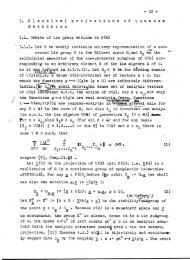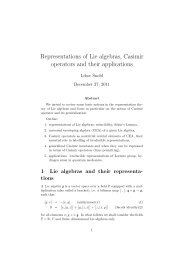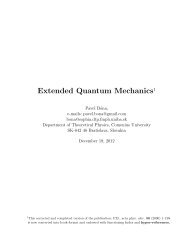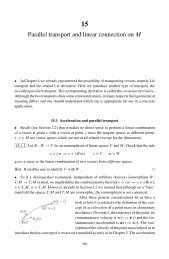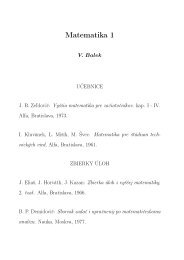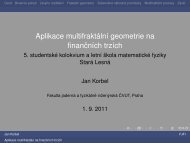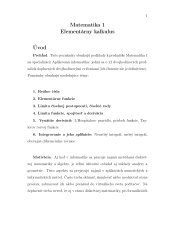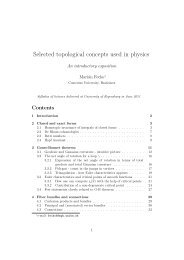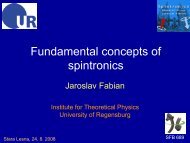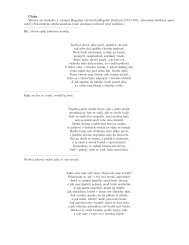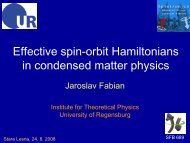Quantum Field Theory I
Quantum Field Theory I
Quantum Field Theory I
Create successful ePaper yourself
Turn your PDF publications into a flip-book with our unique Google optimized e-Paper software.
70 CHAPTER 2. FREE SCALAR QUANTUM FIELD<br />
Representations of the canonical commutation relations without the vacuum<br />
vector are called the strange representations. The above example 22 shows not<br />
only that such representations exist, but that one can obtain (some of) them<br />
from the Fock representation by very simple algebraic manipulations.<br />
As to the Fock representation, it is always available. One just has to postulate<br />
the existence of the vacuum |0〉 and then to build the basis of the Fock<br />
space by repeated action of a + i on |0〉. Let us emphasize that even if we have<br />
proven that existence of such a state does not follow from the commutation<br />
relations in case of infinite many DOF, we are nevertheless free to postulate its<br />
existence and investigate the consequences. The very construction of the Fock<br />
space guarantees that the canonical commutation relations are fulfilled.<br />
Now to the (non-)equivalence of representations. Let us consider two representations<br />
of canonical commutation relations, i.e. two sets of operators a i ,a + i<br />
and a ′ i ,a′+ i in Hilbert spaces H and H ′ correspondingly. The representations<br />
are said to be equivalent if there is an unitary mapping H → U H ′ satisfying<br />
a ′ i = Ua iU −1 and a ′+<br />
i = Ua + i U−1 .<br />
It is quite clear that the Fock representation cannot be equivalent to a<br />
strange one. Indeed, if the representations are equivalent and the non-primed<br />
one is the Fock representation, then defining |0 ′ 〉 = U |0〉 one has ∀i a ′ i |0′ 〉 =<br />
Ua i U −1 U |0〉 = Ua i |0〉 = 0, i.e. there is a vacuum vector in the primed representation,<br />
which cannot be therefore a strange one.<br />
Perhaps less obvious is the fact that as to the canonical commutation relations,<br />
any irreducible representation (no invariant subspaces) with the vacuum<br />
vector is equivalent to the Fock representation. The proof is constructive.<br />
The considered space H ′ contains a subspace H 1 ⊂ H ′ spanned by the basis<br />
|0 ′ 〉, a ′+<br />
i |0 ′ 〉, a ′+<br />
i a ′+<br />
j |0 ′ 〉, ... One defines a linear mapping U from the subspace<br />
H 1 on the Fock space H as follows: U |0 ′ 〉 = |0〉, Ua +′<br />
i |0 ′ 〉 = a + i |0〉,<br />
Ua ′+<br />
i a ′+<br />
j |0 ′ 〉 = a + i a+ j |0〉, ... The mapping U is clearly invertible and preserves<br />
the scalar product, which implies unitarity (Wigner’s theorem). It is<br />
also straightforward that operators are transformed as Ua ′+<br />
i U −1 = a + i and<br />
Ua ′ i U−1 = a i . The only missing piece is to show that H 1 = H ′ and this follows,<br />
not surprisingly, form the irreducibility assumption 23 .<br />
22 Another instructive example (Haag 1955) is provided directly by the free field. Here the<br />
standard annihilation operators are given by a ⃗p = ϕ(⃗p,0) √ ω ⃗p /2 + iπ(⃗p,0)/ √ 2ω ⃗p , where<br />
ω ⃗p = ⃗p 2 + m 2 . But one can define another set a ′ in the same way, just with m replaced<br />
⃗p<br />
by some m ′ ≠ m. Relations between the two sets are (check it) a ′ ⃗p = c +a ⃗p + c − a + √ √<br />
−⃗p and<br />
a ′+<br />
⃗p = c −a + ⃗p +c +a −⃗p , where 2c ± = ω ⃗p ′/ω ⃗p ± ω ⃗p /ω ⃗p ′ . The commutation relations become<br />
[ ]<br />
a ′ ⃗p ,a′+ = (2π) 3 δ(⃗p− ⃗ [ ] [ ]<br />
k)(ω ⃗ ′ k ⃗p −ω ⃗p)/2ω ⃗p ′ and a ′ ⃗p ,a′ = a ′+<br />
⃗ k ⃗p ,a′+ = 0. The rescaled operators<br />
⃗ k<br />
b ⃗p = r ⃗p a ′ ⃗p and b+ ⃗p = r ⃗pa +′ where r ⃗p ⃗p 2 = 2ω′ ⃗p /(ω′ ⃗p − ω ⃗p) constitutes a representation of the<br />
canonical commutation relations.<br />
If there is a vacuum vector for a-operators, i.e. if ∃|0〉∀⃗p a ⃗p |0〉 = 0, then there is no |0 ′ 〉<br />
satisfying ∀⃗p b ⃗p |0 ′ 〉 = 0 (the proof is the same as in the example in the main text). In other<br />
words at least one of the representations under consideration is a strange one.<br />
Yet another example is provided by an extremely simple prescription b ⃗p = a ⃗p +α(⃗p), where<br />
α(⃗p) is a complex-valued function. For ∫ |α(⃗p)| 2 = ∞ this representation is a strange one (the<br />
proof is left to the reader as an exercise)<br />
23 As always with this types of proofs, if one is not quite explicit about definition domains<br />
of operators, the ”proof” is a hint at best. For the real, but still not complicated, proof along<br />
the described lines see Berezin, Metod vtornicnovo kvantovania, p.24.



